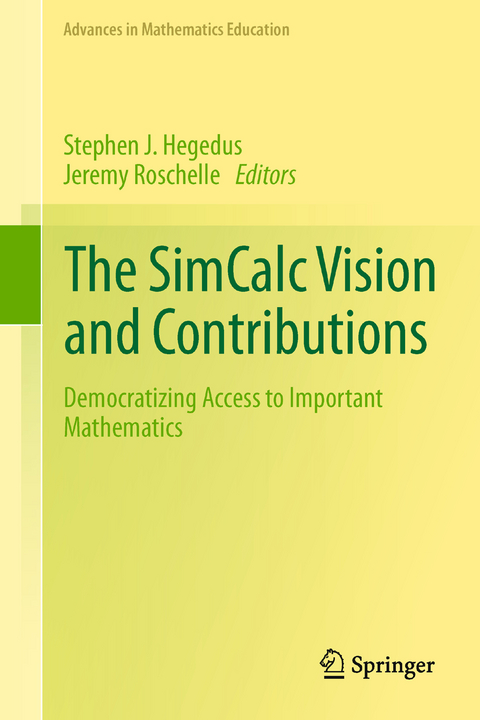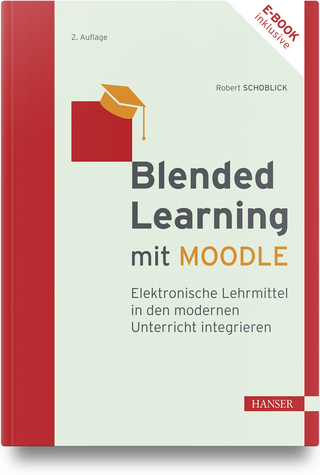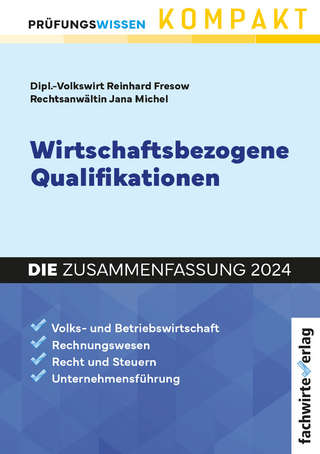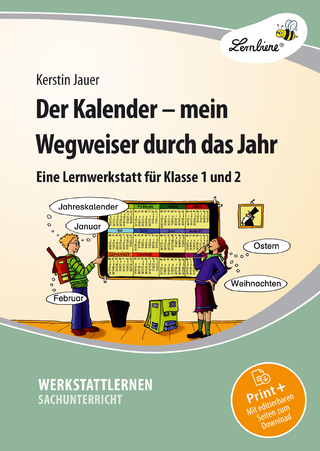
The SimCalc Vision and Contributions
Springer (Verlag)
978-94-007-9207-4 (ISBN)
This volume provides essential guidance for transforming mathematics learning in schools through the use of innovative technology, pedagogy, and curriculum. It presents clear, rigorous evidence of the impact technology can have in improving students learning of important yet complex mathematical concepts -- and goes beyond a focus on technology alone to clearly explain how teacher professional development, pedagogy, curriculum, and student participation and identity each play an essential role in transforming mathematics classrooms with technology. Further, evidence of effectiveness is complemented by insightful case studies of how key factors lead to enhancing learning, including the contributions of design research, classroom discourse, and meaningful assessment.
The volume organizes over 15 years of sustained research by multiple investigators in different states and countries who together developed an approach called "SimCalc" that radically transforms how Algebra and Calculus are taught.
The SimCalc program engages students around simulated motions, such as races on a soccer field, and builds understanding using visual representations such as graphs, and familiar representations such as stories to help students to develop meaning for more abstract mathematical symbols. Further, the SimCalc program leverages classroom wireless networks to increase participation by all students in doing, talking about, and reflecting on mathematics. Unlike many technology programs, SimCalc research shows the benefits of balanced attention to curriculum, pedagogy, teacher professional development, assessment and technology -- and has proven effectiveness results at the scale of hundreds of schools and classrooms.
Combining the findings of multiple investigators in one accessible volume reveals the depth and breadth of the research program, and engages readers interested in:
* Engaging students in deeplylearning the important concepts in mathematics
* Designing innovative curriculum, software, and professional development
· Effective uses of technology to improve mathematics education
* Creating integrated systems of teaching that transform mathematics classrooms
* Scaling up new pedagogies to hundreds of schools and classrooms
* Conducting research that really matters for the future of mathematics learning
* Engaging students in deeply learning the important concepts in mathematics
* Designing innovative curriculum, software, and professional development
· Effective uses of technology to improve mathematics education
* Creating integrated systems of teaching that transform mathematics classrooms
* Scaling up new pedagogies to hundreds of schools and classrooms
* Conducting research that really matters for the future of mathematics learning
Acknowledgements.- Series Preface: Gabriele Kaiser & Bharath Sriraman.- I. Philosophy & Background.- Preface to Section I: Ubiratan D’Ambrosio.- Introduction:Jeremy Roschelle & Stephen Hegedus.- The Mathematics of Change and Variation from a Millennial Perspective: New Content, New Context (originally appeared in C. Hoyles, C. Morgan, & G. Woodhouse (Eds.), Rethinking the mathematics curriculum (pp. 155-170). London: Springer-Verlag.): James Kaput & Jeremy Roschelle.- From Static to Dynamic Mathematics: Historical and Representational Perspectives (originally appeared in Educational Studies in Mathematics, 68(2), 99-111): Luis Moreno-Armella & Stephen Hegedus: Intersecting Representation and Communication Infrastructures (originally appeared in ZDM: The International Journal on Mathematics Education: Transforming Mathematics Education Through Dynamic Mathematics Technologies, 41(4), 399-412): Stephen Hegedus & Luis Moreno-Armella.- II. Aspects of Design.- Reflections on Significant Developments in Designing SimCalc Software: James Burke, Ryan Robidoux, & Stephen Hegedus.- Designing for Generative Activities: Expanding Spaces for Learning and Teaching: Nancy Ares.- SimCalc and the Networked Classroom: Corey Brady, Tobin White, Sarah Davis, & Stephen Hegedus.- III. Impacts from Large-Scale Research.- Preface to Section III: Jinfa Cai.- SimCalc at Scale: Three Studies Examine the Integration of Technology, Curriculum, and Professional Development for Advancing Middle School Mathematics:Jeremy Roschelle & Nicole Shechtman.- Learning and Participation in High School Classrooms: Sara Dalton & Stephen Hegedus.- Development of Student and Teacher Assessments in Scaling Up SimCalc Project: Nicole Shechtman, Geneva Haertel, Jeremy Roschelle, Jennifer Knudsen, & Corrine Singleton.- Sustainable use of Dynamic Representational Environments: Toward a District-Wide Adoption of SimCalc-Based Materials: Phil Vahey, George J. Roy, & Vivan Fueyo.- Impact of Classroom Connectivity onLearning and Participation: Stephen Hegedus, Luis Moreno-Armella, Sara Dalton, Arden Brookstein, & John Tapper.- IV. Impacts from Small-Scale Research.- Viewing SimCalc Classrooms Through the Lens of Mathematical Discourse: Jessica Pierson Bishop.- Scaling Up Innovative Mathematics in the Middle Grades: Case Studies of “Good Enough” Enactments: Susan Empson, Steven Greenstein, Luz Maldonado, & Jeremy Roschelle.- Changing from the Inside out: SimCalc Teacher Changes in Beliefs and Practices: John Tapper.- Shaping Dialogue Through Questioning: An Examination of the Interactions Among Teachers, Representations, and Mathematics: Chandra Hawley Orrill.- “They Need to be Solid in Standard Skills First”: How Standards Can Become the Upper Bound: Margaret Dickey-Kurdziolek & Deborah Tatar.- V. International Contributions.- Developing and Enhancing Elementary School Students’ Higher Order Mathematical Thinking With SimCalc: Demetra Pitta-Pantazi, Paraskevi Sophocleous, & Constantinos Christou.- Adapting SimCalc to Different School Mathematics Cultures: A Case Study from Brazil: Rosana Nogueira de Lima, Lulu Healy, & Tania Campos.- Mathematical Modeling with SimCalc: Enhancing Student Complex Problem Solving Skills Using a Modeling Approach: Nicholas G. Mousoulides.- Approaching Calculus with SimCalc: Linking Derivative and Antiderivative: Patricia Salinas.- VI. Extensions, Commentaries, & Future Visions: You Can Lead a Horse to Water…: Issues in Deepening Learning Through Deepening Teaching: John Mason.- Multiple Function Max/Min Problems for First Grade Children in the 21st Century”: Richard Lesh, Lyn English, Serife Sevis, & Chanda Riggs.- The Kaputian Program for the Mathematics of Change and Variation and Its Relation to DNR-Based Instruction in Mathematics: Guershon Harel.- The Evolution of Technology and the Mathematics of Change and Variation: David Tall.- Conversation About SimCalc, Its Evolution and Lessons Along the Way: Eric Hamilton & Nora Sabelli.
| Erscheint lt. Verlag | 29.1.2015 |
|---|---|
| Reihe/Serie | Advances in Mathematics Education |
| Zusatzinfo | XII, 480 p. |
| Verlagsort | Dordrecht |
| Sprache | englisch |
| Maße | 155 x 235 mm |
| Themenwelt | Schulbuch / Wörterbuch ► Lernhilfen |
| Schulbuch / Wörterbuch ► Unterrichtsvorbereitung ► Unterrichts-Handreichungen | |
| Mathematik / Informatik ► Mathematik ► Computerprogramme / Computeralgebra | |
| Sozialwissenschaften ► Pädagogik ► Schulpädagogik / Grundschule | |
| Schlagworte | Algebra • algebra-intensive learning • Calculus • Calculus grades 6-13 • Classroom Connectivity • Educational technology • Efficacy Trials • Evolution and SimCalc • Graphical Interpretation • Learning and Motivation • longitudinal impact of SimCalc curriculum • Mathematics of Chang and Variation (MCV) • multiple representations • Networks SimCalc • Prof. James Kaput • Prof. Jim Kaput • Randomized Controlled Trials • Rate and SimCalc • Semiotics and SimCalc • SimCalc project |
| ISBN-10 | 94-007-9207-7 / 9400792077 |
| ISBN-13 | 978-94-007-9207-4 / 9789400792074 |
| Zustand | Neuware |
| Haben Sie eine Frage zum Produkt? |
aus dem Bereich


